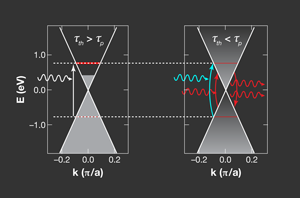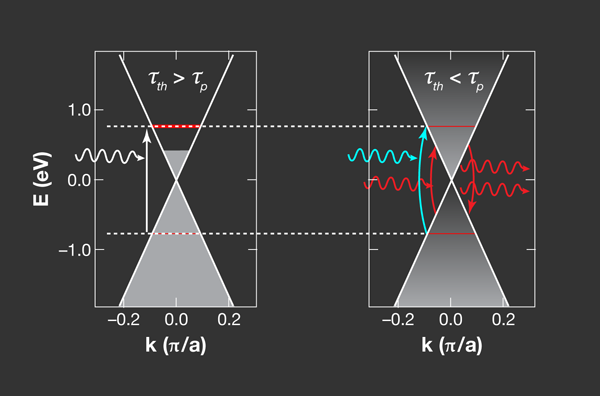Stimulated Near-Infrared Light Emission in Graphene
Graphene—a carbon sheet only one atom thick—provides physicists with a playground to explore exotic quantum phenomena, and engineers with a material with which they may be able to miniaturize electronic devices and catch up with Moore’s law [1,2]. New results reported in Physical Review Letters by Tianqi Li and colleagues at Ames Laboratory and Iowa State University suggest that graphene has also earned its place in the arsenal of promising photonic materials [3]. Li et al. established two necessary conditions for possible lasing applications—a population inversion of charge carriers and optical gain—by exciting graphene with very short pulses of light.
Graphene’s unique mechanical, transport, chemical, and linear optical properties are fairly well established. Up to now, however, the effects of exciting graphene with femtosecond ( 1fs=10-15s) pulses of light that create nonequilibrium charge states—a highly nonlinear process—haven’t been well studied. Yet, nonlinear properties are often the basis of functional optical devices, as they enable functions such as ultrafast modulation and control, and gain. For example, lasing can occur through a process where first an external light source creates an excess of excited states (population inversion) and then a spontaneously emitted photon stimulates these states to emit radiation via a coherent cascade. The coherent light emitted in this way is many times more powerful than the original photon that triggers it. This is why this nonlinear phenomenon is called optical gain.
In their experiment, Li et al. excited an epitaxial graphene monolayer sample with 1.55-eV pump laser pulses of 35-fs duration. With a “probe” pulse of light tuned to 1.55 eV or just below that, they then recorded the difference in reflectivity with or without the pump—a quantity called the ultrafast differential reflectivity. In metals, the relationship between how much light is reflected and absorbed is complex, but because graphene is exceptionally thin and the optical conductivity doesn’t depend on frequency, the reflectivity provides a measure of the absorbed light, which in turn depends on the optical conductivity. The experimental criterion for identifying optical gain in any pumped state is a negative optical conductivity, or negative absorption. This means that there are more photons coming out than coming in. So, when Li et al. observed a negative optical conductivity above a certain pump intensity threshold, they interpreted this as evidence of optical gain.
The fact that Li et al. are able to observe this behavior in graphene relates to this material’s unique properties. When the electrons in a material are excited by light on time scales of the order of femtoseconds, they occupy highly nonequilibrium states. In most materials, the excited electron states are coherent during or immediately after the pulse duration τp, but as the charges collide with themselves and with phonons, this coherence is lost. After a characteristic time interval τth, the charges can be described by a quasithermal transient distribution. Studies of semiconductors and two-dimensional semiconductor quantum wells have shown that when these materials are excited by 10-fs pulses, τth is much longer than τp [4,5]. Such a relaxation parameter regime gives rise to excited states that are most likely to lie within a narrow range of energies around the photon energy (top left, Fig.1). However, since the Pauli exclusion principle prevents more than one charge from occupying each state, this situation results in a small population inversion and limits the light that could be emitted to a small range of frequencies.
Li et al. show that, in graphene, the excited states thermalize on a time scale that is less than the duration of the optical pulse, i.e., τth is less than τp even for a pulse duration that is only ∼10 fs. Their measurements provide evidence that femtosecond laser excitations almost instantaneously produce a broadband population inversion in graphene. The population inversion, where the electronic states are described by an hourglass-type distribution, is broadband and in quasiequilibrium after a mere 10 fs (top right, Fig.1).
The group found that broadband optical gain emerges over a wide energy window, up to hundreds of meV’s below the pump photon energy. They observed for the first time femtosecond stimulated emission and gain above a threshold photoexcited carrier density of ∼1013– 1014 per cm2 for 1.55-eV pump photons, which is close to a complete nonlinear absorption saturation of the pump field. Though this is not the first ultrafast spectroscopy study of graphene, earlier experiments used relatively weak laser intensities to excite the charge carriers, so they did not see these nonlinear effects [6–11].
Li et al.’s current study opens exciting opportunities to explore optical gain from terahertz to ultraviolet frequencies, a much wider range of frequencies than what is seen in conventional lasing materials. This broad optical gain is a special feature of graphene because, due to its characteristic linear energy dispersion, the photoexcited carriers scatter extremely fast among themselves and relax into a wide band of excited states. Another distinct feature in Li et al.’s work is that it takes less than 35 fs for them to build up the broadband gain. This result is quite impressive, as what normally happens in materials when electrons are excited by short pulses is that the states fill up and the Pauli exclusion principle blocks more carriers from being excited. In graphene, however, an ultrabroadband gain ranging from the conical point to the excitation energy can be established within ∼10 fs. In the context of nonlinear materials and ultrafast materials science, this is a unique result.
Li et al.’s result that a pronounced population inversion can be created in graphene and can lead to optical gain in the infrared spectrum makes it possible to explore optical applications of graphene in laser technology and telecommunications that might surpass the present performance of semiconductor quantum wells. Such applications include extremely fast modulators, better absorbers that saturate at high intensities, broadband gain media, and lasing from the visible to the terahertz. Although the unique nonlinear optical properties in graphene, revealed by Li et al., set the stage for using this material as an emerging gain medium, there is still a long way to go before we can fully use it. For example, the short lifetime and high pumping rate for the gain states in graphene will require some clever engineering for novel optical functionalities, and it will be necessary to develop reliable ways to fabricate high-quality monolayer and few-layer graphene with a large surface area.
References
- A. K. Geim and P. Kim, Sci. Am. 298 (4),90 (2008)
- A. H. Castro Neto, F. Guinea, N. M. R. Peres, K. S. Novoselov, and A. K. Geim, Rev. Mod. Phys. 81, 109 (2009)
- T. Li, L. Luo, M. Hupalo, J. Zhang, M. C. Tringides, J. Schmalian, and J. Wang, Phys. Rev. Lett. 108, 167401 (2012)
- J.-L.Oudar, D. Hulin, A. Migus, A. Antonetti, and F. Alexandre, Phys. Rev. Lett. 55, 2074 (1985)
- W. H. Knox, C. Hirlimann, D. A. B. Miller, J. Shah, D. S. Chemla, and C. V. Shank, Phys. Rev. Lett. 56, 1191 (1986)
- J. M. Dawlaty, S. Shivaraman, M. Chandrashekhar, F. Rana, and M. G. Spencer, Appl. Phys. Lett. 92, 042116 (2008)
- P. A. George, J. Strait, J. Dawlaty, S. Shivaraman, M. Chandrashekhar, F. Rana, M. G. Spencer, Nano Lett. 8,4248 (2008)
- D. Sun, C. Divin, J. Rioux, J. Sipe, C. Berger, W. A. de Heer, P. N. First, T. B. Norris, Nano Lett. 10,1293 (2010)
- M. Breusing, C. Ropers, and T. Elsaesser, Phys. Rev. Lett. 102, 086809 (2009)
- R. W. Newson, J. Dean, B. Schmidt, and H. M. van Driel, Opt. Express 17, 2326 (2009)
- D. Sun, Z. Wu, C. Divin, X. Li, C. Berger, W. A. de Heer, P. N. First, and T. B. Norris, Phys. Rev. Lett. 101, 157402 (2008)





